- Research
- Fish tagging
- Lumpfish research
- Oceanography
- Seabed mapping
- Arnarfjörður
- Drekasvæði
- Ísafjarðardjúp
- Jökulbanki
- Jökuldjúp
- Kolbeinseyjarhryggur and adjacent area
- Kolluáll
- Langanesgrunn
- Látragrunn
- Nesdjúp
- Reykjaneshryggur and adjacent area
- Selvogsbanki
- South of Selvogsbanki
- South of Skeiðarárdjúp
- South of Skerjadjúp
- Southeast of Lónsdjúp
- Southwest of Jökuldjúp
- Suðausturmið
- Suðurdjúp
- Vesturdjúp
- East of Reykjaneshryggur
- Vestfjardarmid
- Seal research
- Whale Research
- Advice
- About
First record of Humpback whale movement between Cape Verde and West Greenland
26. April 2024
 On the figure, the pink shade represents the breeding destination of humpback whale feeding in the Western feeding area (Composed of the Gulf of Maine, Atlantic Canada and West Greenland feeding grounds). The orange shaded areas represent the breeding destinations of humpback whale feeding at the Eastern feeding grounds. The yellow shaded region represents the breeding grounds in the West Indies. The top left corner shows a photograph of NA04936 taken on the 4th of July 2021 (©Glacialis expedition), and the bottom right corner, a photograph of NA04936 taken on the 24th of March 1999 of the Cape Verde Islands (©Beatrice Jann). From Chosson et al 2024.
On the figure, the pink shade represents the breeding destination of humpback whale feeding in the Western feeding area (Composed of the Gulf of Maine, Atlantic Canada and West Greenland feeding grounds). The orange shaded areas represent the breeding destinations of humpback whale feeding at the Eastern feeding grounds. The yellow shaded region represents the breeding grounds in the West Indies. The top left corner shows a photograph of NA04936 taken on the 4th of July 2021 (©Glacialis expedition), and the bottom right corner, a photograph of NA04936 taken on the 24th of March 1999 of the Cape Verde Islands (©Beatrice Jann). From Chosson et al 2024.
First record of Humpback whale movement between Cape Verde and West Greenland
For the first time, an individual humpback that was photographed in the Cape Verde Islands breeding ground off the coast of Africa has been photographed in the west Greenland feeding ground.
Humpback whales migrate annually between the breeding grounds located in the southern Atlantic, by the Caribbean and the coast of Africa, and feeding grounds in the north. There is still a lot unknown about the annual long-distance migrations of these majestic animals.
Due to a large international monitoring effort, based on photo-identification and satellite tagging, the commonly accepted hypothesis is that humpback whales feeding on the western side of the North-Atlantic (from off the coast of USA, to west Greenland) migrate to the western breeding grounds (Caribbean, Greater and Lesser Antilles). Humpback whale from the eastern side of the North-Atlantic (Iceland and Norway) migrate, however, to the breeding grounds on both sides of the North Atlantic. The monitoring of the humpbacks is possible through the North Atlantic Humpback Whale Catalogue, which is curated by Allied whale.
Observations from the humpback NA04936
The humpback providing this knowledge is known as NA04936. It was photographed and identified off the coast of West Greenland off Nunarsuit, Arsuk in July 2021 during the Glacialis expedition (Atlas Expedition). About 22 years before (in March 1999) it was photographed and documented in the Cape Verde Islands.
Link to the article on Ecology and Evolution
Link to Allied Whale
Link to Glacialis Expedition
